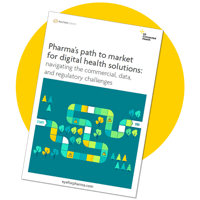Pharma companies have long been using data, whether it’s to accelerate drug discovery and development, or improve clinical trials.
But with the advent of digital therapeutics and digital health solutions, data has become the lifeblood of the pharmaceutical industry, providing insights that allow us to drive efficiency, better meet stakeholder needs, and create tools that make a real difference. In fact, Deloitte predicts that by 2022 healthcare data will be a national infrastructure priority.
Not all data though is created equally. For pharma firms looking to deliver real value to patients and clinicians, it’s essential that captured data is clinically valid, reliable, and insightful enough to bring real value to your business.
In this blog we’ll explore how data is transforming pharma, and how you can better obtain, use, and manage your data to achieve improved outcomes for patients, clinicians, and your business.
The power of data
By using data to develop digital health solutions and digital therapeutics, pharma companies can help stakeholders across the care pathway in a number of ways:
- Earlier identification and diagnosis: Data from clinically validated assessments can be used by clinicians to help with early identification and diagnosis, meaning patients can start treatment sooner and see the benefits faster.
- Personalized management and treatment: Data allows clinicians to personalize the management of a condition by enabling them to better understand the challenges, behaviors, side-effects, adherence, and life-style factors patients are facing, as well as receiving more accurate guidance on the treatment itself. Addressing these potential barriers makes it more likely that patients will stick with treatment longer term.
In addition to this, data allows clinicians to take personalization to the next level, providing them with oversight of how patients are doing in real-time, so more informed management of treatments can be prescribed. Whether adjusting dosage – for example, in diabetes treatments – tweaking treatment regimes, or changing the treatment prescribed, data enables clinicians to guarantee treatment plans are as effective as possible.
- Advanced notification and preventative care: Data helps clinicians spot patterns and allows them to take preventative actions or give advance warning of potential changes in patient health/deterioration.
- Understanding disease progression: Using real-world data to understand disease progression, over time, across different patient cohorts provides a better picture of the natural history of a disease, and thus guidance in the future development of treatments. A clinical tool such as TrackSMA, for example, which is used by clinicians to capture data from a range of clinical assessments to help monitor individual patients with Spinal Muscular Atrophy (SMA), also generates real-world evidence (RWE). By using evidence-based validated clinical assessments, data from different regions can be combined to provide a better understanding of the disease and individual patient cohorts. This approach is particularly important when addressing the challenge of widely-dispersed patient populations associated with rare diseases.
- Label expansion/use: Data offers real-world evidence to expand label approval for a broader range of indications. Data from male breast cancer sufferers, for example, proved pivotal in convincing US regulators to extend drug use to men without the need for an additional clinical trial.
How to identify and obtain the right data
When used correctly, data can deliver real value not just in the long term, but in the short-to-medium term, too. But how do you gather the right data to achieve your objectives?
The first step is setting objectives. Setting and gaining alignment around a clear set of objectives will inform your strategy on how best to create and launch your solution, giving a greater understanding of the costs, level of effort, and evidence requirements entailed, as well as the regulatory burden and potential data return you will capture.
Once you know what data you require, to obtain it, you need to deliver a solution that is useful and valuable to all potential users. After all, if patients and clinicians don’t see the value your proposed solution will bring, they have little incentive to engage with you or input the data. This may seem obvious but it’s surprising how often it is overlooked.If in doubt, the key to maximizing value for patients, clinicians, and other stakeholders is to always ensure your solution meets a defined unmet need, and that it scrupulously addresses concerns around data management, consent, and privacy. Using the solution should be easy and not generate an additional burden if end-users are to adopt it into their already busy daily schedules.
Optimizing data management
Managing the gathering and storage of patient data is often presented as the most challenging part in the process, but it’s not as difficult as it might seem. It all comes down to having a structured approach, and a data management platform that enables flexibility.
Firstly, it’s important to outline individual responsibilities and be clear as to who can access different types of personal and de-identified data. This helps maintain confidentiality, and ensures every individual knows what action they’re expected to take to protect data, both on a day to day basis, and in case of any issues.
Secondly, data management steps need to be user-friendly for those who will actually use the data, or they simply won’t bother.
With countless data protection regulations across the world – and strict penalties for infringement – care should also be taken to localize consent when gathering data from different regions. That means paying close attention to where data is stored and transmitted to, as well as where it is collected, to avoid any breaches or cybersecurity issues.
Cybersecurity is paramount at all times. That means keeping data secure not just at rest, but in transit too.
Data is no longer optional
When it comes to digital health solutions, data is everything. Without the right type of data, handled in the right way, securely managed, and given to the right stakeholders, your digital health solution will simply not succeed.
When managed correctly however, the benefits of data are transformative, and can make a real difference to patient outcomes. In light of changing attitudes to the use of technology to help manage patients resulting from the COVID-19 pandemic, the reluctance to develop solutions at scale is being overcome and those who hesitate to move forward are likely to be left behind.
Matt Norton
Director of Strategy & Client Solutions
S3 Connected Health
For more information on data management and regulation, download our latest whitepaper below:



